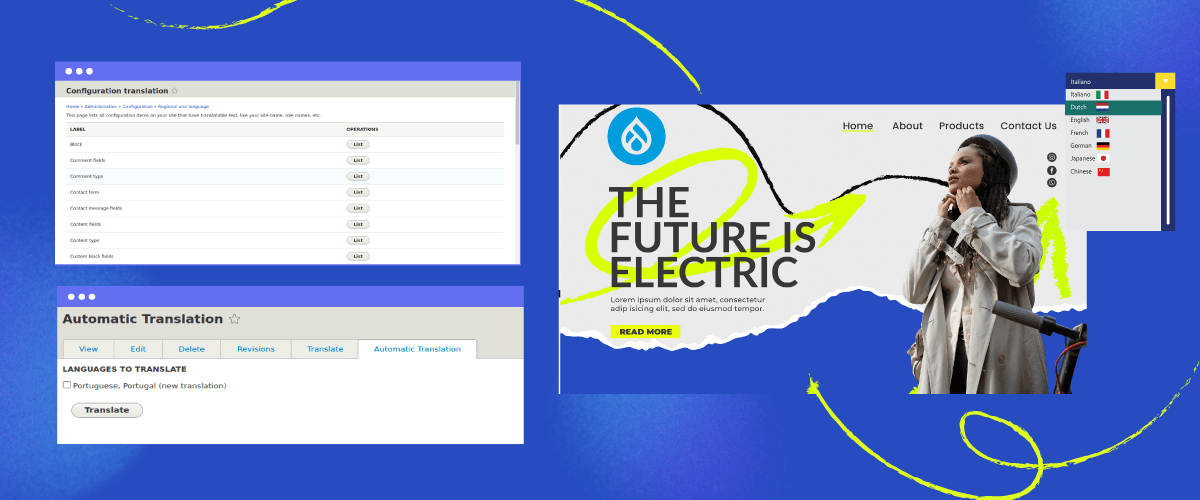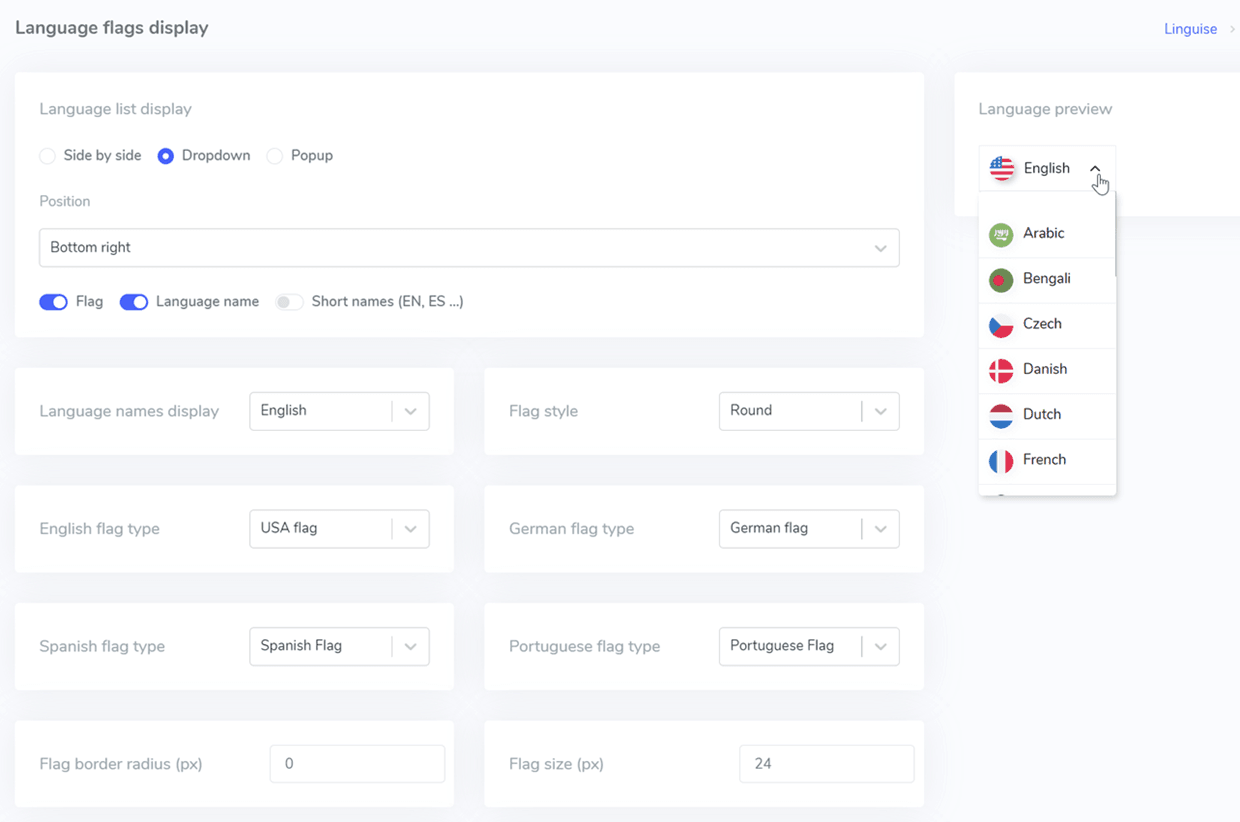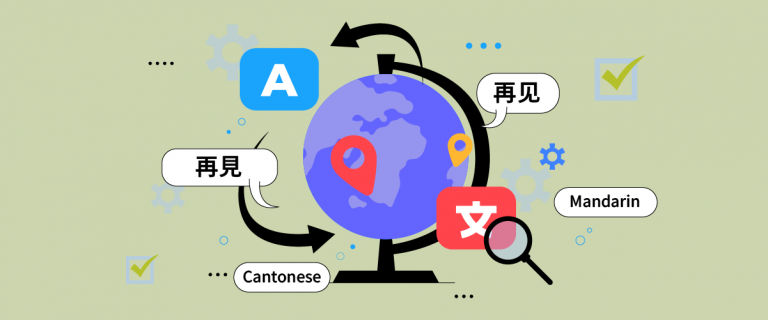How to create automatic translations on Drupal content and modules. Drupal is a CMS that is popularly used by users, Drupal CMS is able to compete with WordPress in creating various types of websites. It’s not surprising that many site owners create their websites using Drupal.
The popularity of multilingual websites is currently increasing, all site owners are competing to make their websites capable of translating into various languages. So how can site owners on Drupal also automatically translate their content and modules?
So, in this article we will discuss in full how to make automatic translations of Drupal content and modules using one of the automatic translation services. Let’s continue reading below.
Several methods to translate your Drupal Content and modules
Before getting into automatic translation in Drupal, there are several methods to translate your Drupal content and modules. Here are some options.
Drupal built-in multilingual module
One method that can be used to translate Drupal content and modules is to use Drupal’s built-in multilingual module. This module is provided by Drupal by default, but keep in mind that this method can be quite complicated and requires technical expertise. However, using Drupal’s built-in multilingual modules allows you to translate content and modules more seamlessly into the system.
However, one of the main drawbacks is the level of technical expertise required. The translation process using Drupal’s built-in modules requires a deep understanding of Drupal’s structure and module configuration.
What Drupal’s built-in translation method lacks is a weakness and the ability to edit translations directly. The inability to edit translations directly and dynamically can be an obstacle if there is a need to make changes or adjustments to translations quickly and easily.
Third party translation services
In addition to Drupal’s built-in modules, there are also third-party translation options that you can find convenient. There are various choices of third party translation services, one of which is a translation service such as Linguise. Linguise is an automatic translation that supports various CMS, one of which is translate Drupal CMS.
Using Linguise, you can easily translate Drupal content and modules without needing to have in-depth technical knowledge. Linguise offers a user-friendly interface and intuitive tools, allowing you to translate your Drupal site quickly and efficiently. Plus, Linguise also offers great customer support, so you can get help if you have any problems or questions.
Choosing a third-party translation option like Linguise can be a good alternative if you are looking for a simpler solution that doesn’t require in-depth technical knowledge.
Therefore, you can use Linguise as one of the methods to create automatic translations. So how do you make automatic translation in Drupal? See the complete method below.
How to make automatic translation on your Drupal website
Linguise is an automated translation platform compatible and integrated with over 40+ CMS and platforms, including CMS Drupal. With Linguise, you can translate your website content into more than 80 diverse languages, ranging from traditional to international.
Linguise uses cloud-based neural and AI Translation technology that enables an accuracy rate of up to 97% perfect translation quality Linguise, which is almost on par with human translations.
With Linguise you can translate Drupal website content and modules so that it can help bring in visitors from other countries and increase website traffic. Here’s how to make and install Linguise automatic translation on Drupal.
Step 1: Register Linguise account
The initial process to sign up involves creating a free account with Linguise and taking advantage of their one-month free trial. To register for a Linguise account, simply provide your email address to create a username and password.
During the trial period, which spans a full month, you will have access to a range of comprehensive and compelling features offered by Linguise. Once the trial period concludes, you will be directed to the Linguise dashboard.
Step 2: Add domain website & generate API key
In the Linguise dashboard, you will need to provide the domain of your Drupal website that requires translation. There are several columns that you need to fill in, including:
- Account
- URLs
- Platforms/CMS
- Language
- Translation language
- Translate URLs
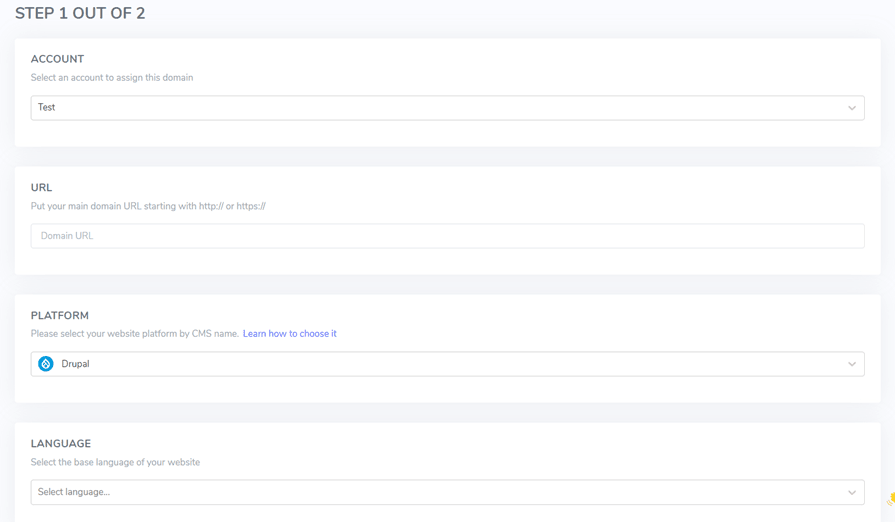
Afterwards, within the API key section, you can choose the option to Copy to clipboard. This allows you to easily copy the API key provided by Linguise for further use or integration with your Drupal website.

Step 3: Upload translation script and activate API key
To utilize the Linguise translation script, you will need to upload it to the server where your Drupal installation resides. This involves transferring the script file to the appropriate directory on your server, ensuring that it is accessible and properly integrated with your Drupal setup.
Once you have downloaded the script, extract or unzip the file. Then, upload the extracted files to the root folder of your CMS installation, where your Drupal files are located. It is important to ensure that the linguise folder, which contains the script files, remains in its default name linguise and is placed at the root level of your website. This ensures proper functionality and integration with your Drupal CMS.

To incorporate the Linguise API key into your setup, you will need to locate the Configuration.php file that you previously uploaded to your server. Open the file for editing and locate the specific section where the API key needs to be inserted. Inside this section, you will find a line of code with a placeholder text, typically REPLACE_BY_YOUR_TOKEN.

Step 4: Setup the Drupal URLs rewriting
By default, Drupal has URL rewriting enabled. To confirm this setting, you can navigate to the Configuration section in the top menu bar of your Drupal admin interface. From there, go to Search and metadata, and then select URL aliases. This will allow you to verify that URL rewriting is indeed active.
It’s worth noting that if you are using the Pathauto module in Drupal, the multilingual URLs will also be functional.
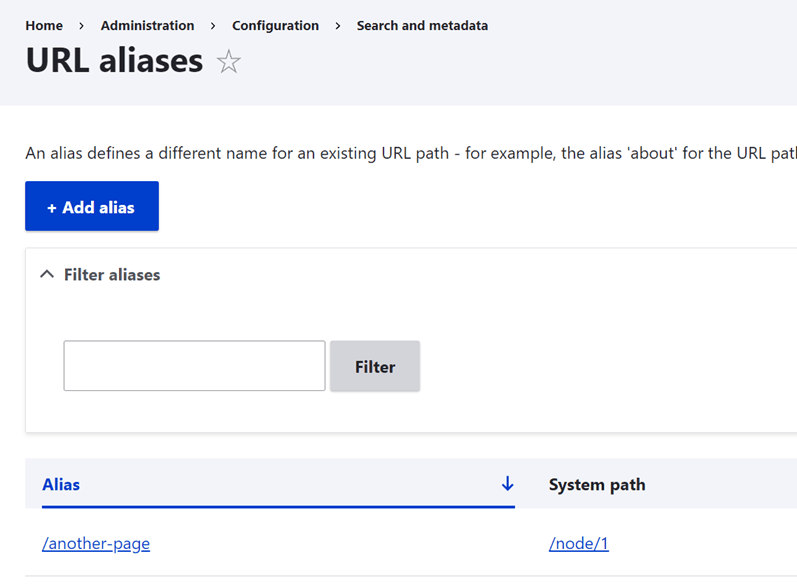
To set the URL according to the language in Drupal, you need to make adjustments to the .htaccess file located in the main directory of your Drupal installation. You can copy the following code and place it after the RewriteEngine on line which is already present in Drupal’s built-in .htaccess file by default.
<IfModule mod_rewrite.c>
RewriteEngine On
RewriteRule ^(af|sq|am|ar|hy|az|eu|be|bn|bs|bg|ca|ceb|ny|zh-cn|zh-tw|co|hr|cs|da|nl|en|eo|et|tl|fi|fr|fy|gl|ka|de|el|gu|ht|ha|haw|iw|hi|hmn|hu|is|ig|id|ga|it|ja|jw|kn|kk|km|ko|ku|ky|lo|la|lv|lt|lb|mk|mg|ms|ml|mt|mi|mr|mn|my|ne|no|ps|fa|pl|pt|pa|ro|ru|sm|gd|sr|st|sn|sd|si|sk|sl|so|es|su|sw|sv|tg|ta|te|th|tr|uk|ur|uz|vi|cy|xh|yi|yo|zu|zz-zz)(?:$|/)(.*)$ linguise/linguise.php?linguise_language=$1&original_url=$2 [L,QSA]
</IfModule>
After making adjustments to the .htaccess file as explained previously, here is an example of what the final .htaccess file will look like on your Drupal installation.
Step 5: Activate & setup language switcher
The next step we can activate the language switcher and its settings. The language switcher is a pop-up in the form of a flag that allows the user to select the desired language. To install it, you need to copy the code given at the end of the website configuration and place it at the top of your HTML page.
After that, the flag language switcher will be loaded automatically and made available to the user. To do this, open the Linguise dashboard then find the following script.

To include content in your page header, you can utilize a Drupal module called Add to Head. Click on Configuration > Development > Add profile.

Lastly, ensure that the script location is validated or verified.

By default, the language switcher will appear in a floating position at the top right of your website. You have the freedom to customize its appearance using CSS according to your preferences.
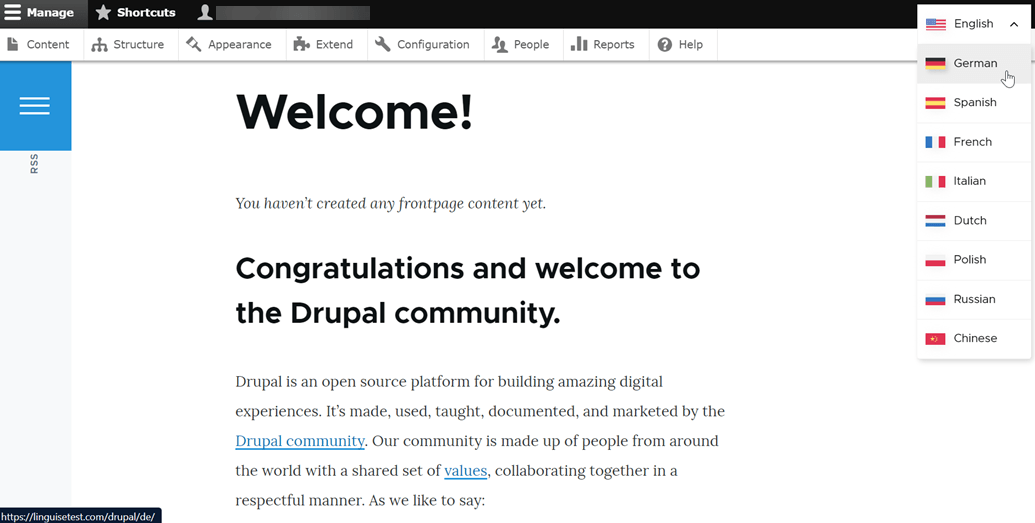
Additionally, you can customize the language switcher by accessing the Linguise dashboard and navigating to the Settings section. From there, go to the Language flag display settings. Any modifications made in this section will automatically be applied to the language switcher on your website.

You can find the preview of the language switcher on the right side of the screen. In this preview, you can configure the following elements.
- 3 layouts: side by side, dropdown or popup
- The language switcher position
- The language switcher content
- Flags shapes and size
- Flags box shadow
- Flags style
- Languages names hover color
- Flag box shadow on hover
- Language popup hover color and several others that you can find on the Linguise dashboard.
Step 6: Activate local cache system
As an alternative, you have the option to enable a local cache system that stores URLs and their corresponding multilingual content. This cache system is designed to enhance page loading speed by reducing data transfer between the Linguise server and your website server.
The cache is utilized only for previously translated pages that have not been updated. The cache prioritizes the most frequently viewed multilingual pages.
Additionally, you can specify the amount of cache to be stored in megabytes (MB). In the following example, the cache is activated, and the specified cache size is 200MB.

Step 7: Start translate your Drupal website
After setting up a few things from creating a Linguise account, configuring API keys, language switcher, to local cache, it’s time to try translating the Drupal website into a language other than the default language English.
To do this, open the website page then click on the language switcher as follows. For example, we will translate it into German.

After that, the system will automatically translate the page into German for a few seconds, then a display of the successfully translated page will appear.
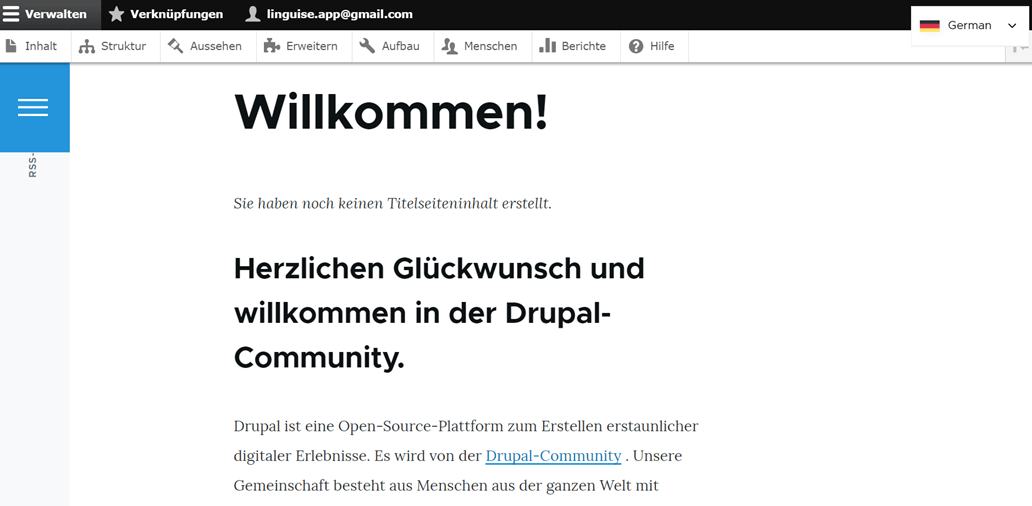
How? It’s really easy to make automatic translations in Drupal. With Linguise, you only need to take 7 easy steps to add automatic translation to Drupal.
Once the language switcher is active and you have selected the target language, your content and modules will be automatically translated when you select the language switcher.
So you don’t need to manually translate any content on your site.
SEO strategies can implemented in Drupal to improve multilingual websites
After successfully automatically translating a Drupal website, you must continue to improve website performance so that traffic increases and visitors are easier to find, one of which is by implementing mtulilingual SEO.
In fact, Linguise also 100% supports multilingual SEO, as you can see in the infographic below.
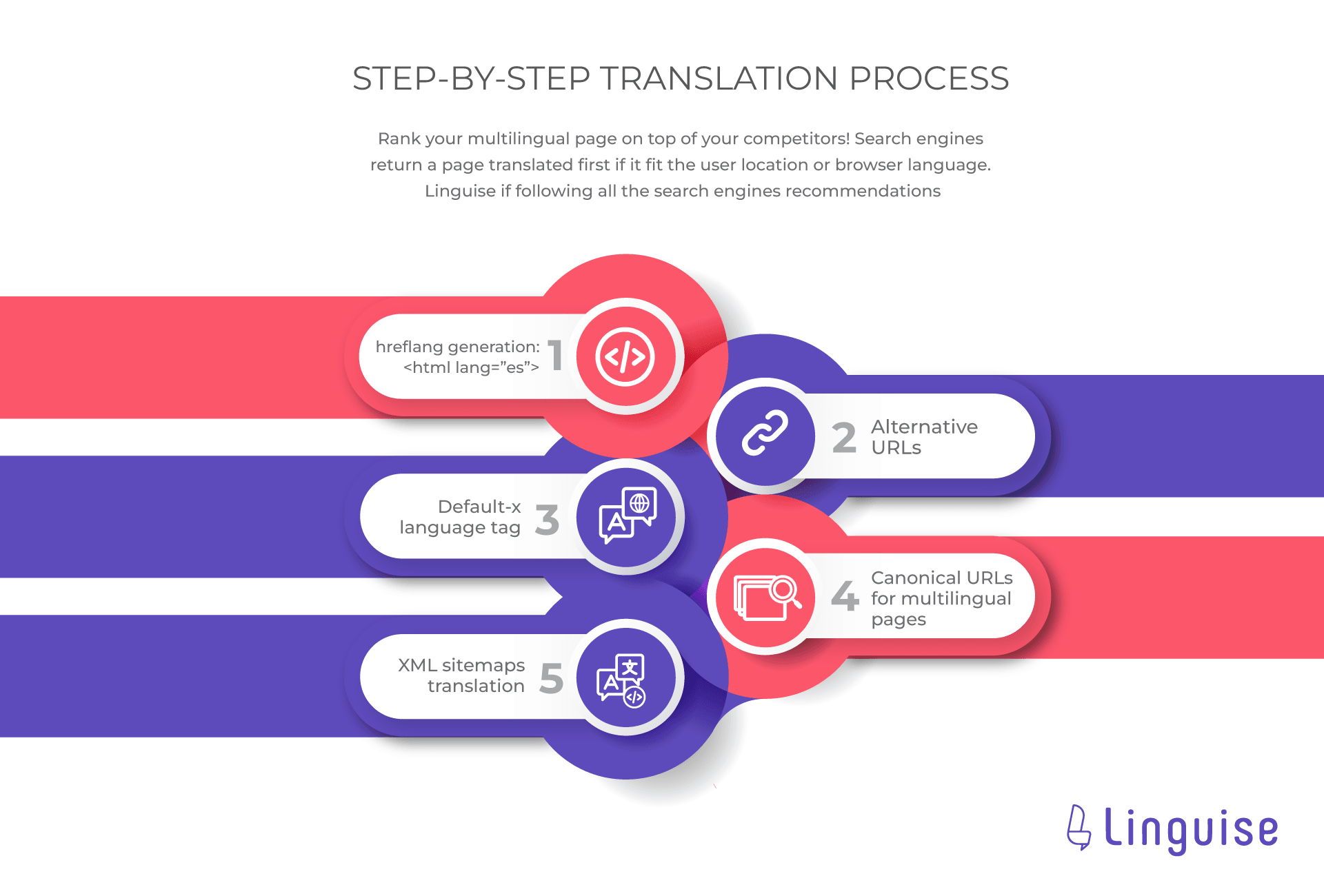
Implementing SEO strategies in Drupal can significantly improve the performance of multilingual websites. Here are some SEO techniques that can be implemented.
- Language-specific URLs: Use language-specific URLs for each translated version of your website. This helps search engines understand the language targeting of each page and improves indexing and ranking.
- Hreflang tags: Apply hreflang tags in the HTML header of your pages to indicate the language and regional targeting of each version. This helps search engines serve appropriate language versions to users based on their location and language preferences. Linguise automatically applies hreflang code to every translated page.
- Translated metadata: Ensure that meta titles, descriptions, and keywords are properly translated for each language version. Linguise also automatically translates metadata for every piece of content in Drupal.
- Language switcher optimization: Optimize the language switcher element to be search engine-friendly. A friendly button switcher can greatly improve the user experience, so that users will have no trouble switching languages.
- Canonical URLs: Implement canonical URLs to specify the preferred version of a page among multiple language versions. Canonical URLs are also automatically generated by Linguise so they are not duplicates.
- XML sitemap: Generate XML sitemaps for each language version of your website. You can generate a multilingual sitemap then submit it to Google Search Console, Linguise will automatically create a multilingual sitemap for your website.
- Multilingual keyword research: Conduct keyword research specific to each target language to identify relevant keywords and phrases. Optimize your content with these keywords to improve visibility in search results for each language version.
By implementing these SEO strategies in Drupal, you can enhance the visibility, ranking, and user experience of your multilingual website, attracting targeted traffic from various language audiences.
Automatic Drupal website translation with Linguise from today!
Now you understand how to create automatic translations for Drupal content and modules. There are several methods to translate Drupal sites and automatic translation is the best solution.
Automatic translation with Linguise makes it easy for you to translate content into 85 language options quickly and easily with just a few clicks.
Even though it is automatic, Linguise has good and natural translation quality, you can even edit the translation results via the front end live editor.
So what are you waiting for? Register a Linguise account immediately and enjoy the complete 1 month free trial feature!

